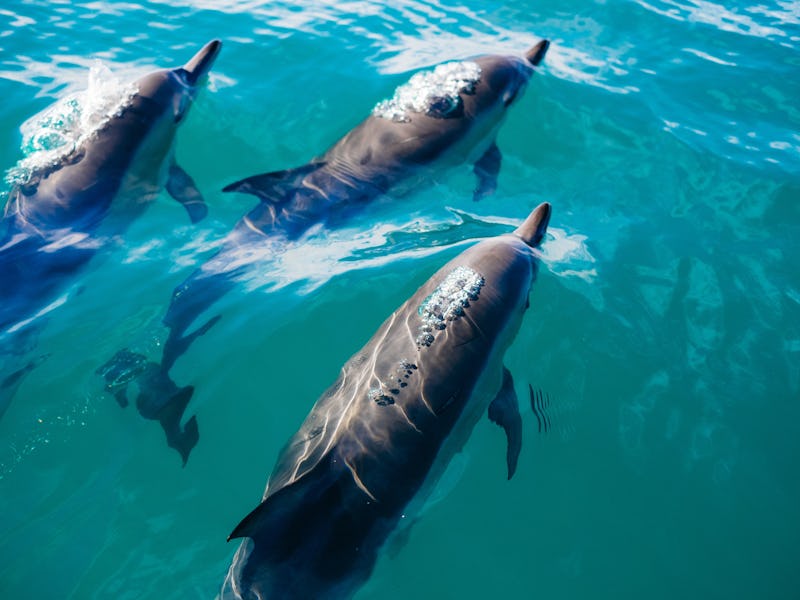Earth dolphins: "Lost" genes transformed Flipper into a water-living creature
The story of these species is written in their genes.

Tens of millions of years ago, whales looked quite a bit different than they do today. Instead of gliding through the water, they had legs and hooves and walked on land — though some did take the occasional aquatic excursion. But the transition from land-lubbers to water-dwellers didn’t happen overnight. The order of marine mammals called cetaceans, which includes whales, dolphins, and porpoises, evolved over millions of years to lose the legs and devote full time to swimming.
It took some serious bodily changes for cetaceans to survive deep dives below the waves, and new research in Science Advances shows that these changes appear in the DNA of modern cetaceans, offering new clues to exactly what they had to trade for a life spent at sea.
In a study published on Wednesday, a team of researchers presents evidence that when the ancestors of modern cetaceans split off from the ancestors of hippopotamuses, 85 different genes got deactivated. These genes supported all sorts of crucial functions for life on land, like wound healing and saliva production.
But for cetaceans to set sail, they shook these genes loose in favor of more suitable adaptations.
“To efficiently store and conserve oxygen for prolonged breath-hold diving, cetaceans developed a variety of adaptations,” write the study’s authors, led by evolutionary genomicist Michael Hiller, Ph.D., of the Max Planck Institute of Molecular Cell Biology and Genetics in Germany.
Among these adaptations were larger oxygen stores — a result of increased blood volume and more concentrated blood — as well as a respiratory system that let the animals quickly breathe out and in when they surface, and flexible ribs that let the lungs collapse.
To anyone familiar with human anatomy, this last adaptation might sound like an extremely bad, potentially life-threatening thing. But for cetaceans, collapsible lungs are essential for taking deep dives and not popping right back up to the surface.
Diving deep doesn't just require big lungs, it also requires lungs that can collapse under pressure to avoid excessive buoyancy.
Additionally, while cetaceans’ ancestors produced saliva, this is unnecessary for animals who gulp down huge quantities of water along with their meals. So they simply don’t produce it anymore.
They also deactivated a gene involved in blood clotting, which prevents the dangerous blood clots that could cause strokes when whales quickly dive and resurface.
For each of these adaptations, the researchers identified genes that had been inactivated through the cetaceans’ evolutionary history. In total, they found 85, 62 of which had not been previously reported.
The team explains that these gene losses seem to serve two functions: First, they’re associated with hyper-specific adaptations — like the lung thing — that help aquatic animals thrive and compete. And second, they appear tobe crucial parts of the transition from land to sea.
So on the one hand, these gene losses make cetaceans more effective swimmers and water dwellers, while on the other hand, these gene losses simply make them cetaceans at all.
“More generally, our study highlights important genomic changes that occurred during the transition from land to water in the cetacean lineage and thus helps to understand the molecular determinants of their remarkable adaptations,” they write.
After all, complex evolutionary histories don’t just happen. They’re the result of survival, mutation, sexual reproduction, and all the environmental factors that influence those things.
In short, whales did not simply decide to hop in the water and ditch their hooves. They evolved slowly, over millions of years, to become the dedicated marine mammals that they are today.
And now we know that this history is written in their genes.
Abstract: The transition from land to water in whales and dolphins (cetaceans) was accompanied by remarkable adaptations. To reveal genomic changes that occurred during this transition, we screened for protein-coding genes that were inactivated in the ancestral cetacean lineage. We found 85 gene losses. Some of these were likely beneficial for cetaceans, for example, by reducing the risk of thrombus formation during diving (F12 and KLKB1), erroneous DNA damage repair (POLM), and oxidative stress–induced lung inflammation (MAP3K19). Additional gene losses may reflect other diving-related adaptations, such as enhanced vasoconstriction during the diving response (mediated by SLC6A18) and altered pulmonary surfactant composition (SEC14L3), while loss of SLC4A9 relates to a reduced need for saliva. Last, loss of melatonin synthesis and receptor genes (AANAT, ASMT, and MTNR1A/B) may have been a precondition for adopting unihemispheric sleep. Our findings suggest that some genes lost in ancestral cetaceans were likely involved in adapting to a fully aquatic lifestyle.